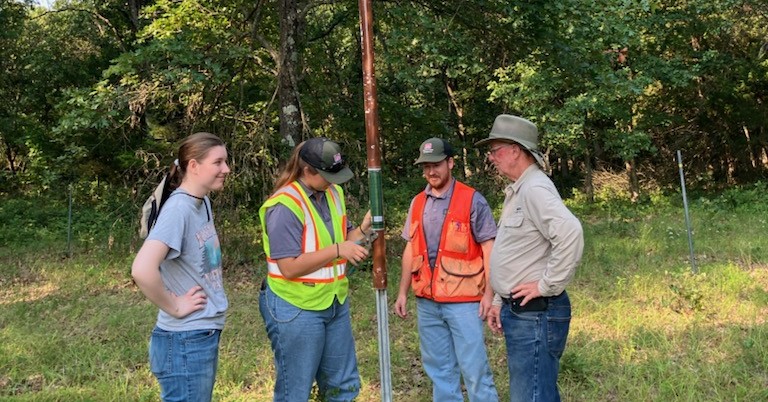Master Naturalists study Indiana bat population in northeast Missouri

INDIAN CREEK, Mo. – Members of the Mississippi Hills Missouri Master Naturalist chapter of the Hannibal area are excited about a growing population of an endangered bat species that inhabits two locations in northeast Missouri.
The chapter, sponsored by the University of Missouri Extension and the Missouri Department of Conservation (MDC), works with the U.S. Army Corps of Engineers, MDC and other partners to study the Indiana bat population near the Mississippi River and Mark Twain Lake.
Perhaps no one would have been more delighted to learn this than Mark Twain, born in Monroe County and raised in Hannibal. In “The Adventures of Huckleberry Finn,” Twain describes bats as “beautifully soft and silky; I do not know any creature that is pleasanter to the touch …”
In 2018, members of the Mississippi Hills chapter began observing six species of bats living near an old limestone mine along the Hannibal’s riverfront. The Sodalis Nature Preserve is home to the largest known hibernaculum, or refuge, for the Indiana bat (Myotis sodalis).
The Indiana bat is a small migratory bat that hibernates in caves and mines in the winter. In summer, it migrates to wooded areas and seems to be attracted to locations with nearby sources of water, says Shelly Colatskie, bat ecologist with MDC. The species is found only in North America and in only 16 U.S. states. The U.S. Fish and Wildlife Service placed the Indiana bat on the Federal endangered species list in the late 1960s.
The Sodalis Preserve bat population in Hannibal grew from 204,368 to 222,129 bats in 2024, according to a U.S. Fish and Wildlife census. That is almost half of the total Indiana bat population, which is estimated to be around 530,000.
Master Naturalist Bob Kendrick says the growth is surprising considering threats such as white-nose syndrome, a fungal disease that has caused the Indiana bat population to decline by more than 70 percent since the disease began spreading. Bat populations also face risks from the destruction of forests and increased use of pesticides, he says. A new risk is electric windmills with blades that travel at up to 225 mph.
Despite their negative image, bats play an important ecological role in Missouri. They help control populations of night-flying insects such as mosquitoes, says Robert Pierce, MU Extension state wildlife and fisheries specialist. The Indiana bat is a social mammal that hibernates mostly in limestone caves or mines from October through April and spends the summer months using other types of habitats such as those around Mark Twain Lake.
The Indian Creek Recreation Area of Mark Twain Lake is a perfect location for female bats because of availability of water, hardwood species and open flyways along old logging trails. Female bats raise their pups under the bark of hardwoods, including the sloughing bark of shagbark hickory, elm and ash.
The U.S. Fish and Wildlife Service, in partnership with the Corps of Engineers, installed transmitters on a select group of bats in 2022. This provides information for Corps officials to document the range and location of these bats during the summer.
Master Naturalists are working on a timber stand improvement project at Mark Twain Lake as part of their efforts to improve bat habitat. Proper timber management reduces competition among trees and allows more light into the forest floor to encourage plant growth.
Master Naturalists also remove invasive plants from the forest and perform prescribed burns to encourage the growth of forbs and herbaceous plants, which promotes plant and insect diversity, says Kendrick.
Corps of Engineers personnel lead efforts to determine what habitat features are attracting bats to the Indian Creek Recreation Area, located on the northern banks of 18,600-acre Mark Twain Lake. The area is rich in winged insects such as butterflies, moths, beetles, mosquitoes and midges that draw the nocturnal feeders.
The team also discovered that the Indian Creek Recreation Area contains numerous old logging trails that now serve as locations for hunting blinds during the lake’s specialty hunts for disabled hunters. The trails provide an open, easy path for bats to travel in and out of forested areas.
The Corps team began monitoring the bats at Indian Creek in 2024. Corps personnel placed acoustic monitors that identify bats by their sounds and echo sounding frequencies within the area. The technology provides data to measure activity levels at the locations. After the initial trial, Corps staff requested the help of Master Naturalist volunteers to monitor and help collect data.
While the study is new, Kendrick is encouraged that Master Naturalists are improving the overall environment in northeastern Missouri through numerous collaborative conservation projects.
Learn more at http://muext.us/MasterNaturalist.
Related story: Master Naturalists: Improving Missouri’s environment for 20 years
Miss Clipping Out Stories to Save for Later?
Click the Purchase Story button below to order a print of this story. We will print it for you on matte photo paper to keep forever.

